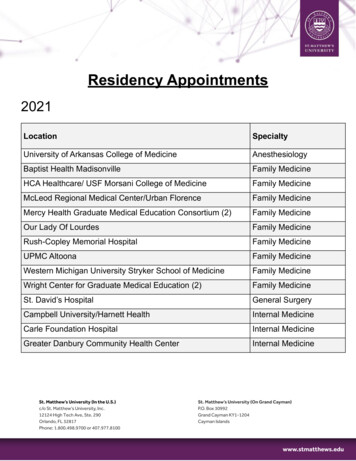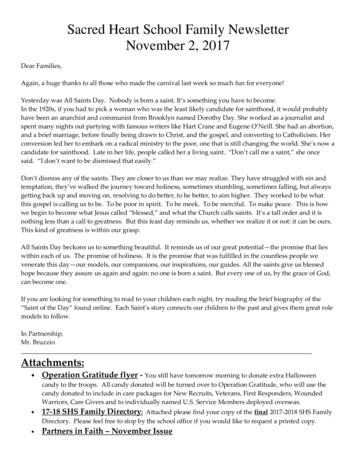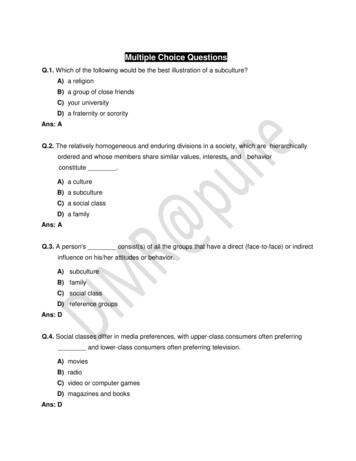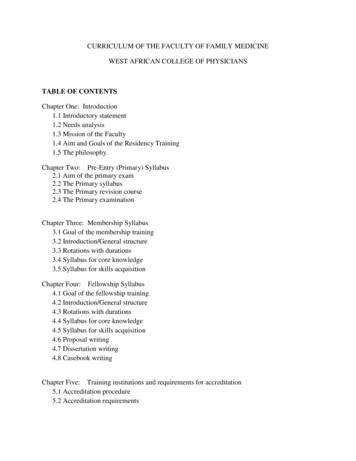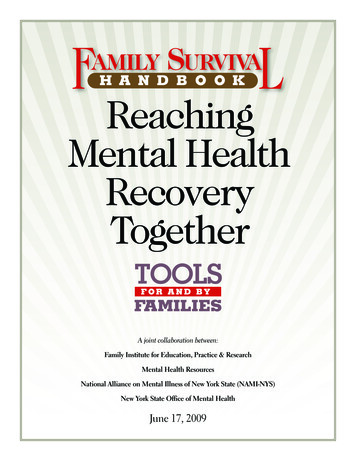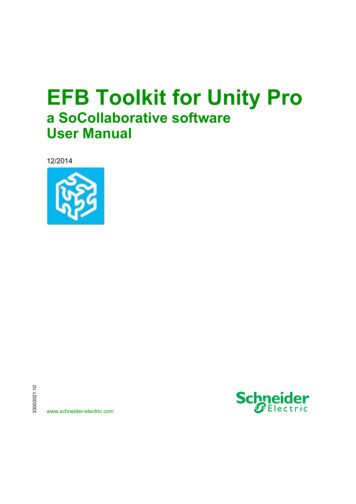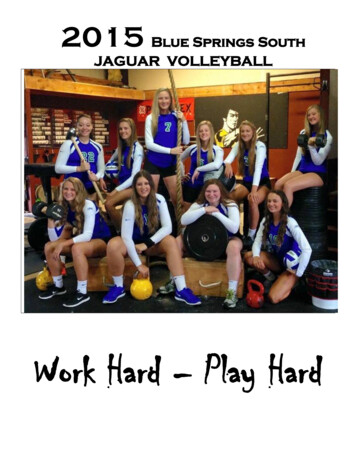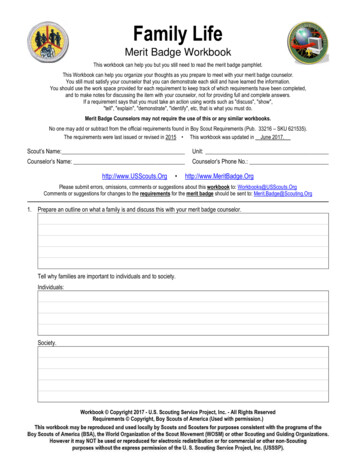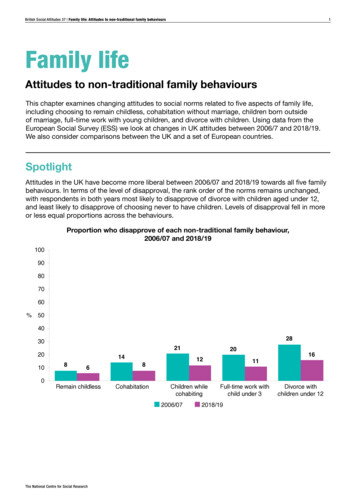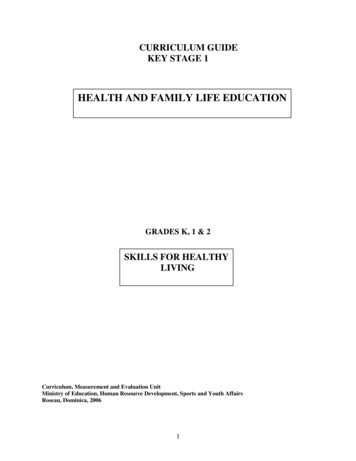
Transcription
CURRICULUM GUIDEKEY STAGE 1HEALTH AND FAMILY LIFE EDUCATIONGRADES K, 1 & 2SKILLS FOR HEALTHYLIVINGCurriculum, Measurement and Evaluation UnitMinistry of Education, Human Resource Development, Sports and Youth AffairsRoseau, Dominica, 20061
HEALTH AND FAMILY LIFE EDUCATION (HFLE)HFLE is a powerful educational programme that provides childrenand young people with a positive view of HEALTH and its benefitsto them NOW and in the FUTURE. It is essentially classroomeducation that seeks to empower children and young people withknowledge and skills for healthy living, preparing them to copeeffectively with the many challenges of life.2
HFLE: SUBJECT STRAND INTEGRATIONValuesSkillsSocial, Emotional& SpiritualWell- BeingSexuality&Sexual HealthAppropriateEating & FitnessManaging theEnvironmentAttitudeBehaviourADDRESSING THE COMPLEXITY AND CONNECTEDNESS BETWEEN VARIOUSCONCEPTS, GOALS, COMPONENTS AND STANDARDS ASSOCIATED WITHATTITUDE AND BEHAVIOUR CHANGE.3
CONTENTSPAGEIntroductionAttainment TargetsK Term 1: SummaryK Unit 1: Who Am I?Topic 1: Self AwarenessTopic 2: Reverence to FaithTopic 3: RelationshipsK Unit 2: Is Our Environment Safe?Topic 1: Home and School EnvironmentTopic 2: Health and SafetyK Term 2: SummaryK Unit 3: How Do I Keep Fit?Topic 1: NutritionTopic 2: Exercise, Rest and HygieneK Unit 4: What Should I do?Topic 1: GenderTopic 2: Work and CareerK Term 3: SummaryK Unit 5: How Do I Care for Myself and Others?Topic 1: Respect for Self and OthersTopic 2: Awareness of HIV and AIDSTopic 3: Drug Awareness4
Grade 1 Term 1: SummaryGrade 1 Unit 1: Who Am I?Topic 1: Self AwarenessTopic 2: Reverence to FaithTopic 3: RelationshipsGrade 1 Unit 2: Is Our Environment Safe?Topic 1: Home and School EnvironmentTopic 2: Health and SafetyGrade 1 Term 2: SummaryGrade 1 Unit 3: How Do I Keep Fit?Topic 1: NutritionTopic 2: Exercise, Rest and HygieneGrade 1 Unit 4: What Should I do?Topic 1: GenderTopic 2: Work and CareerGrade 1 Term 3: SummaryGrade 1 Unit 5: How Do I Care for Myself and Others?Topic 1: Respect for Self and OthersTopic 2: Awareness of HIV and AIDSTopic 3: Drug Awareness5
Grade 2 Term 1: SummaryGrade 2 Unit 1: Who Am I?Topic 1: Self AwarenessTopic 2: Reverence to FaithTopic 3: RelationshipsGrade 2 Unit 2: Is Our Environment Safe?Topic 1: Home and School EnvironmentTopic 2: Health and SafetyGrade 2 Term 2: SummaryGrade 2 Unit 3: How Do I Keep Fit?Topic 1: NutritionTopic 2: Exercise, Rest and HygieneGrade 2 Unit 4: What Should I do?Topic 1: GenderTopic 2: Work and CareerGrade 2 Term 3: SummaryGrade 2 Unit 5: How Do I Care for Myself and Others?Topic 1: Respect for Self and OthersTopic 2: Awareness of HIV and AIDSTopic 3: Drug AwarenessLife SkillsExemplar Lesson Plans1. Self Awareness (Grade K)2. Respect for Self and Others (Grade 1)3. Relationships (Grade 2)6
INTRODUCTIONThis Health and Family Life Education (HFLE) curriculum guide is designed to enable allprimary school teachers to empower students with the confidence they need to believe inthemselves and to help them understand the importance of taking responsibility for their ownhealth.A very critical aim of this new curriculum guide is to help students achieve certain AttainmentTargets as identified in the document. Attainment targets are what students should know,should be able to do, and the desirable attitudes and values that they should display in eachsubject by the end of the compulsory years of schooling. Additionally, the proposedprogramme embodies life-skills and other psychosocial competencies that our children and youthshould develop as they grow into adult hood.Structure of the GuideThe HFLE curriculum has been developed in keeping with the standards of the NationalCurriculum and the HFLE Regional Curriculum Framework. The content is guided by four broadprinciples or themes that form the bedrock of the HFLE programme. These themes are Social,Emotional and Spiritual Well Being, Appropriate Eating and Fitness, Sexuality and SexualHealth, and, Managing the Environment.The content is so developed that for each unit at each grade level there are for main action areas:a) Learning Outcomes – Learning Outcomes are derived directly from the AttainmentTargets and provide a measure of the learner’s achievement of the same. They indicatethe depth and breadth of what learners should know, be able to do, and the desirableattitudes and values they should demonstrate at the end of each Key Stageb) Success Criteria – Success Criteria are derived directly from individual LearningOutcomes. They can be seen as stepping stones/ bench marks to achieving the LearningOutcomesc) Suggested Activities – Suggested Activities are activities in which students may beinvolved in order to realise the Learning Outcomed) Assessment Strategies – Assessment Strategies are mechanisms to determine the extent towhich the Learning Outcomes have been achieved.A time frame has been recommended for the teaching of each Unit in terms of number ofsessions/teaching periods. However, it is advised that teachers avoid focusing on curriculumcoverage. Rather, we suggest that teachers provide opportunity for students to have meaningfulinteraction with the materials with a view to promoting in students positive behavioural andattitudinal change.The guide also contains a sample of lesson plans, a list of Life Skills and some useful tips for theteacher.7
ATTAINMENT TARGETSAT: 1The learner will be able to demonstrate an appreciation of the diverse natureof people, to live and work effectively as an individual, a member of a familyand a community with respect for gender equity, individual rights,responsibility and show reverence to a supreme creator.(SOCIAL, EMOTIONAL AND SPIRITUAL WELL-BEING – STRAND 1)AT: 2The learner will be able to recognise and appreciate the benefits ofappropriate dietary and fitness habits to promote healthy lifestyles forthemselves, their families and the nation.(APPROPRIATE EATING AND FITNESS – STRAND 2)AT: 3The learner will be able to develop a critical understanding of humansexuality, analyse the influence of socio-cultural and economic factors on theexpression of sexuality and demonstrate the ability to make appropriatechoices relating to their sexual well-being.(SEXUALITY AND SEXUAL HEALTH – STRAND 3)AT: 4The learner will demonstrate the use of acquired life skills and positiveattitudes in responding to challenges in the environment, make informeddecisions using local, regional and global issues to ensure that theenvironment is sustained for use by present and future generations.(MANAGING THE ENVIRONMENT – STRAND 4)8
GRADE KTERM 1SUMMARYSESSIONSUNIT 1WHO AM I?TOPICAT: 1 LO:1 SC: 1-3SELF AWARENESS4-6TOPIC 2AT: 1 LO:2 SC: 1-4REVERENCE TO FAITH3-4TOPIC 3AT: 1 LO: 3 SC: 1-4RELATIONSHIPS3-4UNIT 2IS OUR ENVIRONMENT SAFE?TOPIC 1AT: 4 LO: 1 SC: 1-5HOME AND SCHOOL ENVIRONMENT 4-6TOPIC 2AT: 4 LO: 2 SC: 1-3HEALTH AND SAFETY4-6TOTAL (24-26)9PAGE
GRADE KUNIT 1TOPIC 1:SELF AWARENESSSTRAND 1:SOCIAL, EMOTIONAL AND SPIRITUAL WELL BEINGSESSIONS:4-6LO 1:DISPLAY AN AWARENESS OF SELF AND EMOTIONSSUCCESS CRITERIA:1.2.3.ACTIVITIES:RESOURCES:WHO AM I?Recognise that they are alike and special.Describe themselves positively in simple terms.Describe their families and their position in the family. Listen to positive statements made by teacher about themselves. State what they like about self/others/family. Describe how they feel about who they are. Draw pictures about self and friends. Sing along positive things about themselves e. g. the song “I amSpecial”. Use play dough (locally made) to create images of the family. Draw paper faces and stick them on an ‘I am Special Tree’.Chart, rhymes, crayons, songs, drawing paper, play doughSkills: Self awareness, self esteem, communication, creative thinkingTeacher Note: Ensure that students concentrate on positive attributes. ‘I am Special Tree’can be made from dried branches.10
ASSESSMENT:1. Draw a picture of yourself and write two words which describe you.2. Draw a line to join pictures to names.FatherMother11
GRADE KUNIT 1WHO AM I?TOPIC 2:REVERENCE TO FAITHSTRAND 1:SOCIAL, EMOTIONAL AND SPIRITUAL WELL BEINGSESSIONS:3-4LO 2:SHOW REVERENCE ACCORDING TO ONE’S FAITH.SUCCESS CRITERIAACTIVITIES:RESOURCES:1.2.3.4.Show Spiritual Gratitude for life.Sing and enjoy Spiritual choruses and songs of praise.Recite simple prayers according to one’s faith.Respond positively to moments of silence and prayer. Engage in singing songs of praise and thanksgiving! Engage in discussion on the goodness of the Creator. Sing along choruses or hymns in assembly and class. Demonstrate and exercise respect during spiritual activities. Share stories, poems or prayers encouraging reverence to Creator. Participate and take turns in leading class assemblies.Poems, rhymes, hymns, prayers, pictures of spiritual activity.Skills: Self awareness, creative thinking, communicationTeacher Note: Description of the Creator should be restricted to the affective and notphysical.ASSESSMENT:Recite a verse of scripture or rhyme about the Creator.Write/repeat two words to describe God/Creator.12
GRADE KTOPIC 3:STRAND 1:UNIT 1WHO AM I?RELATIONSHIPSSOCIAL, EMOTIONAL AND SPIRITUAL WELL BEINGSESSIONS:3-4LO 3:BUILD GOOD RELATIONSHIPS AT HOME AND SCHOOLSUCCESS CRITERIA:1.2.3.4.ACTIVITIES:. RESOURCES:.Show concern for others by sharing and caring.Share positive events and experiences with others duringsharing time.Keep the rules at school and home.Carry out chores at home and at school.Use photographs/pictures to share positive events and experienceswithin the family.Dramatise stories with reflect sharing e.g. “Anansi and thePlantains” and Bible Stories (Wisdom of Zeraphat). Participate in sharing/helping activities e.g. sharing snacks andtoys, distributing books, tying each other’s shoe laces. Listen to stories that reflect the importance of good manners in thedevelopment of relationships (page 15 The Greens Move). Discuss the importance of school rules and consequences ofbreaking them. Role play chores done at home.Pictures of positive events in the family, book – Anansi Stories, toys,snacks13
Skills: Communication, self-awareness, empathy, interpersonal relationship skillsTeacher Note: Scrap book can be verified by parents at home.ASSESSMENT:1. Put anext to things you share.2. State at least two reasons why school rules should be obeyed (orally).3. Recite rhyme depicting good manners!4. Design a scrapbook to record chores done at home and at school.14
GRADE KUNIT 2IS OUR ENVIRONMENT SAFE?TOPIC 1:HOME AND SCHOOL ENVIRONMENTSTRAND 4:MANAGING THE ENVIRONMENTSESSIONS:4-6LO 1:APPRECIATE THE BEAUTY OF HOME AND SCHOOLSUCCESS CRITERIA: .1.2.3.4.Cultivate and care for a plant at school or at home.Demonstrate proper disposal habits e.g. using bin wisely.Make a visual of a beautiful environment of their choice.Avoid cruelty and unnecessary killing of little creaturesthrough songs, rhymes and actions.5. Demonstrate respect for one’s own property, that of others andthe school.ACTIVITIES:. Visit or look at beautiful area(s) close to school. Name things found in the environment e.g. animals, flowers, trees,rocks/stones etc. Grow plants in an area on school compound or in non-breakable pots. Care for a plant daily. Use pictures to identify particular areas of the home/school anddemonstrate activities which take place in each area. Visit a farmhouse in the neighbourhood to observe how animals arecared for. Participate in nature walk around the school to observe and discusscare to be taken of plants and animals in the environment.15
Bring in /draw pictures of pets and identify their favourite. Suggest ways of making their classroom clean. Role play ways to show respect for the property of others in the class.Skills: Creative thinking, problem solving, decision-makingTeachers Note: Teachers should help students to see and appreciate beauty in the worldaround themRESOURCES:Garbage bins, non – breakable pots, manila paper, plants, markers, glueASSESSMENT:1. Put a tick next to pictures of good environmental practice.2. Draw three things that should/should not be in the schoolsurroundings.3. 4. Colour each part of the home/school in a different colour eg. Kitchen blue, library orange, garden green16
GRADE KUNIT 2TOPIC 2:HEALTH AND SAFETYSTRAND 4:MANAGING THE ENVIRONMENTSESSIONS:4-6LO 2:DISCUSS THE FACTORS THAT CONTRIBUTE TO A SAFEAND HEALTHY ENVIRONMENT AT HOME AND SCHOOL.SUCCESS CRITERIA:1.ACTIVITIES:IS OUR ENVIRONMENT SAFE?Look at pictures/posters of school environments and identifypotential dangers that could cause accidents at school.2.Discuss and demonstrate understanding of appropriate actionsto avoid and deal with simple accidents when they happen.3.Make a list of games, activities and objects that could bedangerous to them and others. Listen to talk by resource person on safety practices in general. Examine the pictures of hazardous objects and discuss safety inrelation to those objects. Listen to and discuss stories about keeping safe e.g. Page 19 (GreensMove) Grade 2 Reader. Practice fire drills/safety measures. Draw illustrations of hazardous objects. View/discuss film on Barney and keeping safe. Participate in a walk around the school to identify areas of potentialdanger and discuss steps to be taken to avoid accidents/harm in thoseareas.17
RESOURCES:Barney cassettes, Grade 2 Reader, stories, resources persons, hazardousobjects, picturesSkills: Communication, problem solving, decision making, critical thinkingTeacher Note: Impress on students that some accidents can be avoided if one followssafety rules.ASSESSMENT:1. Put a tick () on objects which are dangerous to play with.2. State safety practices at least (4).4.Put these pictures in order to show the right practice during a firedrill. (Pictures).18
GRADE KTERM 2 SUMMARYSESSIONSUNIT 3HOW DO I KEEP FIT?TOPIC 1AT:2 LO:2 SC:1-3NUTRITION4-6TOPIC 2AT:2 LO:3 SC:1-4EXERCISE, REST AND HYGIENE4-6UNIT 4WHAT WILL I DO?TOPIC 1AT:3 LO:1 SC:1-4GENDER4-6TOPIC 2AT:1 LO:4 SC:1-5WORK AND CAREER3-4TOTAL (20-22)19PAGE
GRADE KUNIT 3:HOW DO I KEEP FIT?TOPIC 1:NUTRITIONSTRAND 2:APPROPRIATE EATING AND FITNESSSESSIONS:4–6LO 2:APPRECIATE THE NEED TO EAT NUTRITIONAL MEALSEVERY DAY.SUCCESS CRITERIA:1. Use different art forms to show basic foods eaten at breakfast,lunch and supper.2. Discuss reasons for eating healthy meals.3. In groups prepare display of a sample of nutritional foodsACTIVITIES:RESOURCES: Discuss pictures of foods they would eat for various meals. Draw clocks to correspond to meal times. Talk about why we eat food. Sort snacks into ‘healthy’ and ‘not so healthy’ groups. Talk about the ‘goodness’ of healthy snacks. Discuss dangers of eating unhealthy snacks. Recite rhymes and jingles about food. Work in groups to set up a display of local foods.Chart, posters, pictures, paper, crayons, local foods20
Skills: Decision making, creative thinking,Teacher Note: Teacher should use this opportunity to dissuade students from snackingon foods such as sweets, soft drinks, chocolates, coconut cheese etc. Activity 1. may bebroken down into three different activities relating to breakfast, lunch and supper.ASSESSMENT:1.Draw foods eaten for breakfast, lunch and supper.2.Draw a circle around foods that are healthy.3.Give reasons for eating healthy foods (oral).4.Put a cross against foods to avoid.21
GRADE KUNIT 3:TOPIC 2:EXERCISE, REST AND HYGIENESTRAND 2:APPROPRIATE EATING AND FITNESSSESSIONS:4-6LO 3:ENGAGE IN BODY MOVEMENTS THAT ENHANCE FITNESS,REST AND HYGIENESUCCESS CRITERIA:.1.2.3.4.5.ACTIVITIES:HOW DO I KEEP FIT?.Use a variety of movements to imitate climbing ladders,marching, tracing, waving.Demonstrate washing their hands after use of the toilet (andother hygienic practices).Participate in Physical Education and sporting activities atschool.Participate in activities for rest.Practice good posture. Listen to stories to show the importance of exercise, rest andcleanliness. Engage in different exercises and observe heart beat before and afterexercise.Sing action songs with emphasis on fitness, rest, and hygiene e.g.-Heads, shoulders, knees and toes;-Simon works with one hammer, two hammers etc. after tenhammers, he goes to bed (rest)-This is the way we brush our teeth (x3)This is the way we brush out teeth early in the morning. Recite poems that stress the importance of rest. e.g.,-Early to bed, early to riseMakes a person healthy and wise Demonstrate how to bathe and dress using dolls (male and female).22
RESOURCES: Discuss the importance of water and its use for hygienic purposese.g. for bathing, brushing teeth. Participate in rest period after lunch. Listen to a talk by dentist/dental auxiliary. Imitate good posture as demonstrated by teacher (sitting, standing,walking).Tape recorder, audio cassette, dolls (male, female). Resource person(dentist) chart, pictures, stories, songs, poemsSkills: Self-esteem, self-awareness, communication, decision-making, criticalthinkingTeacher Note: The importance of play and rest should be stressed. Students should beallowed to talk about their bed time e.g. how they get ready, what time they go to bed etc.They should also practice good posture during the singing of the National Anthem andprayers. Teacher can, in addition to suggested assessment strategy, use checklists toassess observable hygiene habits in students.ASSESSMENT:1.Use ticks (hygiene habits e.g.) and crosses (XX) to identify good/badHYGIENE HABITSBrush teeth after each mealWash hair regularlyEating without washinghands() (X)2. Orally explain, in simple statements, the importance of rest.23
GRADE KUNIT 4:TOPIC 1:GENDERSTRAND 3:SEXUALITY AND SEXUAL HEALTHSESSIONS:4-6LO 1:.SUCCESS CRITERIA:1.2.3.4.5.ACTIVITIES: RESOURCES:WHAT WILL I DO?DISCUSS THE SIMILARITIES AND DIFFERENCESBETWEEN MALE AND FEMALEDiscuss what makes a boy a boy and a girl a girl.Identify persons as male or female.Sing songs, rhymes about boys and girls that are gendersensitiveUse words related to gender appropriately.Make a visual representation of similarities and differencesbetween male and female.Critically examine pictures of boys and girls or toys e.g. (male dolls,female dolls).Present and discuss names of body parts including names of privateparts.Match names of body parts to blank diagram of males and females.Sing along rhymes/ songs that are gender sensitive.Draw diagrams to show how they view males and females.Pictures, flash cards, blank diagrams, songs and rhymesSkills: Communication, critical thinking, decision making, self awarenessTeacher Note: Students can draw match-stick illustrations to represent their perception ofmales and females. This is an opportunity for students to learn the correct names of themale and female genitals.ASSESSMENT:1. Draw and name parts of a male body and female body.2. Identify words relating to a particular gender.24
GRADE KUNIT 4:TOPIC 2:WORK AND CAREERSTRAND 1:SOCIAL, EMOTIONAL AND SPIRITUAL WELL-BEINGSESSIONS:3–4LO 4:DEMONSTRATE AWARENESS OF THE VARIETY OFJOBS/ WORK PEOPLE DO AT HOME AND ELSEWHERESUCCESS CRITERIA:1.2.3.4.5.ACTIVITIES:RESOURCES:WHAT WILL I DO?Identify jobs people do within the home and surrounding.Differentiate between chores and jobs.Speak about the jobs that members of their family do.Articulate a desire to perform a certain job when they are older.Role play jobs they would like to do. Role play chores they do at home. Listen to resource person talk about the work they do. Discuss/ask questions about information given by resource person. Practice taking turns when performing different activities within agroup. State and discuss jobs that different family members do. Discuss preference for jobs that they like. Draw and colour pictures of different careers.Job chart, crayons, drawing papers, posters25
Skills: Communication , problem solving, creative thinkingTeacher Note: In this Unit teachers should emphasize the importance of doingjobs/chores to the best of one’s ability. “Everything worth doing is worth doing well”.Parents who are professionals may be invited in to talk to students about their careers.ASSESSMENT:1. Sketch the chores/jobs that they enjoy doing.2. Match jobs to family members.3. Talk about why jobs/chores should be done properly.26
GRADE KTERM 3SUMMARYUNIT 5HOW DO I CARE FORMYSELF AND OTHERS?SESSIONSTOPIC 2AT:3 LO:2 SC:1-5RESPECT FOR SELF AND OTHERS4-6TOPIC 3AT:3 LO:3 SC:1-2HIV AND AIDS AWARENESS4-6TOPIC 1AT:1 LO:1 SC:1-3DRUG AWARENESS4-6TOTAL (12-18)27PAGE
GRADE KUNIT 5HOW DO I CARE FOR MYSELF ANDOTHERSTOPIC 1:RESPECT FOR SELF AND OTHERSSTRAND 3:SEXUALITY AND SEXUAL HEALTHSESSIONS:4-6LO 2:.DEMONSTRATE AN APPRECIATION OF AND RESPECT FORTHEIR BODIES AND THOSE OF OTHERS.SUCCESS CRITERIA:1.2.3.4.5.ACTIVITIES:RESOURCES:Show pride in themselves as male or female.Understand that certain body parts are ‘private’.Invent their own songs to celebrate themselves/their bodies.Differentiate between ‘good’ and ‘bad’ touches.Demonstrate ways to respond to ‘good’ and ‘bad’ touches. Sing and talk about the song “I am Special” or “I am a Promise”. Display talents that show that they are special. Listen to talk by resource person. Role play appropriate behaviour to protect themselves from “bad”touches. Talk about what to do if they should experience a ‘bad” touch. Create songs, rhymes or poems that show how special they are.Songs, resource person, paper pencilSkills: Self-awareness, self-esteem, assertiveness, decision-making, communicationTeacher Note: Teacher may have an ‘I am Special’ orientation to inform parents aboutthe importance of developing children’s self esteem and to ensure reinforcement ofvalues at home.28
ASSESSMENT:xnext to1. Draw anext to the good touches and anpictures of bad touches such as: touch on vagina, touch on theshoulder, touch on the buttocks.2. Complete sentences which show how to respect the body. e.g.I should sit with my legs .3. Use ‘show’ and ‘tell’ to explain which touches are ‘good’ and‘bad’ and how to respond to the different types of touches.4. Draw a person that represents their sex (boy or girl).29
GRADE KUNIT 5HOW DO I CARE FOR MYSELF ANDOTHERSTOPIC 2:HIV/AIDS AWARENESSSTRAND 3:SEXUALITY AND SEXUAL HEALTHSESSIONS:4-6LO 3:DEMONSTRATE AN AWARENESS OF HIV AND AIDSSUCCESS CRITERIA:1.2.3.ACTIVITIES:Share their understanding of HIV and AIDS.Discuss ways in which they can interact with people living withHIV and AIDS.Role play what to do when another student gets a cut or bruiseduring play. Listen to stories about children who have been infected with HIVand role play how they would respond in similar situations. Express feelings about the condition and situations of children whohave been infected with HIV. Describe what they should do if another child gets a bruise or cut. Play the game “In the river, on the bank” - a True or False gameabout ways in which they can interact with persons who are infectedwith HIV:Students stand on one side of a drawn line, representing the bank.They listen as the teacher makes a statement about how they caninteract with an infected person/child. If the statement is true,students jump in to the river. .If it is false, students will remain onthe bank.The student who gets an answer wrong is out of the game untilthere is a winner.30
RESOURCES:Dramatise a situation where a student bleeds and appropriateaction is taken.Pictures, charts, story books of children, case studySkills: Communication, empathy, creative thinking, critical thinking, assertivenessTeachers Note: Students should be taught how to show empathy even when they areavoiding contact with the blood of an injured person.ASSESSMENT:1. Orally identify from a list of behaviours, the “right” and“wrong” way to behave towards persons infected with HIV orAIDS e.g.-giving a kiss on the cheeks-giving a hand shake-sharing a hug-touching a bruise-sharing a kiss on the lips2. Role play one way in which they would try to make someonewho is ill happy.31
GRADE KUNIT 5TOPIC 3:DRUG AWARENESSSTRAND 1:SOCIAL, EMOTIONAL AND SPIRITUAL WELL-BEINGSESSIONS:4-6LO 1:DEMONSTRATE AN AWARENESS OF DRUGS.SUCCESS CRITERIA:1.2.5.6.Display an awareness of what a drug is.Identify commonly used drugs when seen (charts, posters and inreal life).Classify drugs as ‘good’ and ‘bad’.Identify persons from whom they can accept drugs. e.g. parents,doctors etc.Recite rhymes/jingles for and against the use of bad drugs.Discuss safety measures in relation to drugs. Listen to talk by resource person. Participate in an “Open Day” in which students prepare, display anddiscuss posters made on drugs. Group pictures into ‘good’ and ‘bad’ drugs. Create jingles against the use of ‘bad’ drugs. Draw pictures of drugs. Recite slogans on drugs e.g.-‘Drugs’ is a killer; it makes you insane; it spoils your liverdestroys your brain;-SAY NO TO DRUGS;-Down with coke and ganja, up with agriculture3.4.ACTIVITIES:HOW DO I CARE FOR MYSELF ANDOTHERS andRole play how they should respond to situations when asked to use,buy or sell drugs.32
RESOURCES:Talk about things they may or may not do to prevent harm from‘good’ drugs (colloquially called medicine) e. g. Not drinkingprescribed medicine straight out of the medicine bottle.Bristol Board (manila paper), charts, pictures of drugsmarkers, crayonsSkills: Communication, decision-making, assertiveness, self- esteem, refusal skillsTeacher Note: Health person can speak to students about proper use of medicinesincluding use of good medicines for specific childhood diseases or disorders.ASSESSMENT:1. Write simple sentences against the use of drugs.2. Circle correct responses for positive drug related activities.3. Place pictures of drugs under the correct heading ‘Good’ / ‘Bad’.33
GRADE 1TERM 1SUMMARYSESSIONSUNIT 1WHO AM I?TOPICAT 1: LO1 SC 1-2SELF AWARENESS4-6TOPIC 2AT 1: LO 2 SC 1-5REVERENCE TO FAITH3–4TOPIC 3AT 1: LO3 SC 1-3RELATIONSHIPS4–5UNIT 2IS OUR ENVIRONMENT SAFE?TOPIC 1HOME AND SCHOOLENVIRONMENT3 -4HEALTH AND SAFETY5 -6AT 4: LO1 SC 1-4TOPIC 2AT4: LO 2 SC 1-4TOTAL (23-25)34PAGES
GRADE 1UNIT 1TOPIC 1:SELF AWARENESSSTRAND 1:SOCIAL, EMOTIONAL AND SPIRITUAL WELL-BEINGSESSIONS:4-6L O 1:DEMONSTRATE BASIC SOCIAL SKILLS IN DEVELOPINGGOOD RELATIONSHIPS WITH FAMILY MEMBERS ANDOTHERSSUCCESS CRITERIA:1.2.3.ACTIVITIES: WHO AM I?Recognise that they are alike but unique in the family.Demonstrate through playing games and role play the basicsocial skills of:o Listening while others are speakingo Refraining from laughing at the mistakes of otherso Displaying friendly behaviour (e.g. – hugging, playing,sharing)o Exhibiting fair play regardless of gendero Applauding positive behaviour and achievement ofotherso Interacting with each other in an honest and helpfulwayo Using ‘excuse me’, ‘sorry’ and other polite remarkso Waiting their turnSing the Barney song “I Love You” and demonstrate how wecan show love to others.Role play situations that reflect social graces e.g. waiting their turn,entering and leaving classroom in an orderly manner; using politeexpressions such as ‘excuse me’ and ‘please’. Dramatise the importance of respecting others through socialskills/graces while singing the song “Only one can talk at a time”. Suggest class rules to help develop social skills.35
RESOURCES:Role-play basic similarities and differences in relation to language,cultural habits, clothes, food among groups/races in Dominica(Haitians, Caribs, Blacks, Asians).Bristol board (manila paper), crayon/marker, chalk, visual aides e.g. cutouts of desirable and undesirable social behavioursSkills: Self-awareness, communication, inter-personal relationship skillsTeacher Note: In this Unit, students can learn how to accept others who are different.They should also be encouraged to demonstrate social graces in all settings – home,school, community.ASSESSMENT:1.2.3.Draw pictures that represent their family including a representationof themselves.Recite one class rule that helps to develop social skills.Show and tell positive and negative social behaviours.36
GRADE 1UNIT 1TOPIC 2:REVERENCE TO FAITHSESSIONS:3–4LO 2:RECOGNISE DIFFERENT WAYS OF SHOWINGREVERENCE ACCORDING TO ONE’S FAITHSUCCESS CRITERIA:1.2.3.4.5.ACTIVITIES: WHO AM I?Respect those in authority through cooperation and keepingrules.Respect the worship time of each other’s faith.Practice speaking the truth.Demonstrate qualities of honesty.Participate in prayer time according to one’s faith.Dramatize the correct posture for prayer in terms of their faith.Create class rules and give consequences if not followed.Display posters of religious stories.Listen to or view stories of religious characters which teachadmirable moral principles and discuss these principles e.g.David and Goliath – strength, great possibilities, faithSampson and Delilah – obedienceKing Josiah (age 8) – faithSamuel- obedienceRESOURCES:Stories of religious characters, posters of religious storiesSkills: Communication, interpersonal relationship skills, decision-making, creativethinkingTeacher Note: Teachers must be sensitive to the forms of worship/prayer of differentfaiths and guide students accordinglyASSESSMENT:1. Write a prayer based on their faith.2. Discuss the importance of obedience.37
GRADE 1UNIT 1TOPIC 3:RELATIONSHIPSSESSIONS:4-5LO 3:RECOGNISE AND APPRECIATE THE POSITIVE QUALITIESOF DIFFERENT PEOPLESUCCESS CRITERIA:1.2.3.4.5.ACTIVITIES:WHO AM I?Interact with others in a ways that are honest and helpful.Applaud positive behaviour and achievements of others.Allow others to contribute in areas where they are strong.Encourage efforts in others.Give others a chance to use their talents. .Demonstrate the importance of sharing. Say positive things about others in the class. Role play situations where they are honest, kind, friendly, funny. Discuss “do unto others as you would have them do unto you”. Dramatize stories which reflect sharing. E.g
LIVING . 2 HEALTH AND FAMILY LIFE EDUCATION (HFLE) . Eating & Fitness Environment Attitude Behaviour ADDRESSING THE COMPLEXITY AND CONNECTEDNESS BETWEEN VARIOUS CONCEPTS, GOALS, COMPONENTS AND STANDARDS ASSOCIATED WITH . The guide also contains a sample of lesson plans
